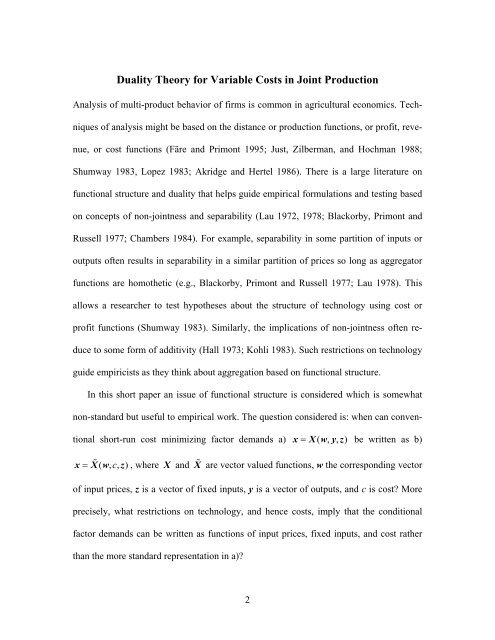Duality Theory for Variable Costs in Joint Production* - ResearchGate
Duality Theory for Variable Costs in Joint Production* - ResearchGate
Duality Theory for Variable Costs in Joint Production* - ResearchGate
You also want an ePaper? Increase the reach of your titles
YUMPU automatically turns print PDFs into web optimized ePapers that Google loves.
<strong>Duality</strong> <strong>Theory</strong> <strong>for</strong> <strong>Variable</strong> <strong>Costs</strong> <strong>in</strong> Jo<strong>in</strong>t Production<br />
Analysis of multi-product behavior of firms is common <strong>in</strong> agricultural economics. Techniques<br />
of analysis might be based on the distance or production functions, or profit, revenue,<br />
or cost functions (Färe and Primont 1995; Just, Zilberman, and Hochman 1988;<br />
Shumway 1983, Lopez 1983; Akridge and Hertel 1986). There is a large literature on<br />
functional structure and duality that helps guide empirical <strong>for</strong>mulations and test<strong>in</strong>g based<br />
on concepts of non-jo<strong>in</strong>tness and separability (Lau 1972, 1978; Blackorby, Primont and<br />
Russell 1977; Chambers 1984). For example, separability <strong>in</strong> some partition of <strong>in</strong>puts or<br />
outputs often results <strong>in</strong> separability <strong>in</strong> a similar partition of prices so long as aggregator<br />
functions are homothetic (e.g., Blackorby, Primont and Russell 1977; Lau 1978). This<br />
allows a researcher to test hypotheses about the structure of technology us<strong>in</strong>g cost or<br />
profit functions (Shumway 1983). Similarly, the implications of non-jo<strong>in</strong>tness often reduce<br />
to some <strong>for</strong>m of additivity (Hall 1973; Kohli 1983). Such restrictions on technology<br />
guide empiricists as they th<strong>in</strong>k about aggregation based on functional structure.<br />
In this short paper an issue of functional structure is considered which is somewhat<br />
non-standard but useful to empirical work. The question considered is: when can conventional<br />
short-run cost m<strong>in</strong>imiz<strong>in</strong>g factor demands a) x = X( w, y, z ) be written as b)<br />
x = X<br />
( w, c, z)<br />
, where X and X are vector valued functions, w the correspond<strong>in</strong>g vector<br />
of <strong>in</strong>put prices, z is a vector of fixed <strong>in</strong>puts, y is a vector of outputs, and c is cost? More<br />
precisely, what restrictions on technology, and hence costs, imply that the conditional<br />
factor demands can be written as functions of <strong>in</strong>put prices, fixed <strong>in</strong>puts, and cost rather<br />
than the more standard representation <strong>in</strong> a)?<br />
2

















